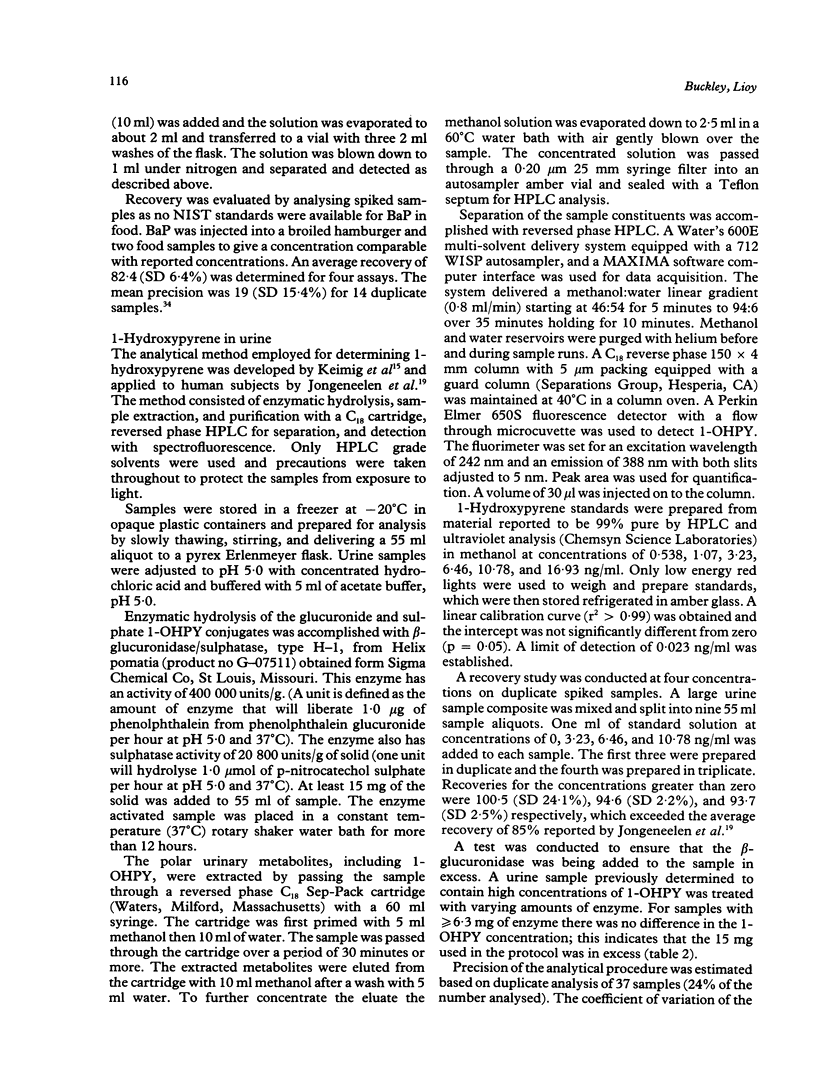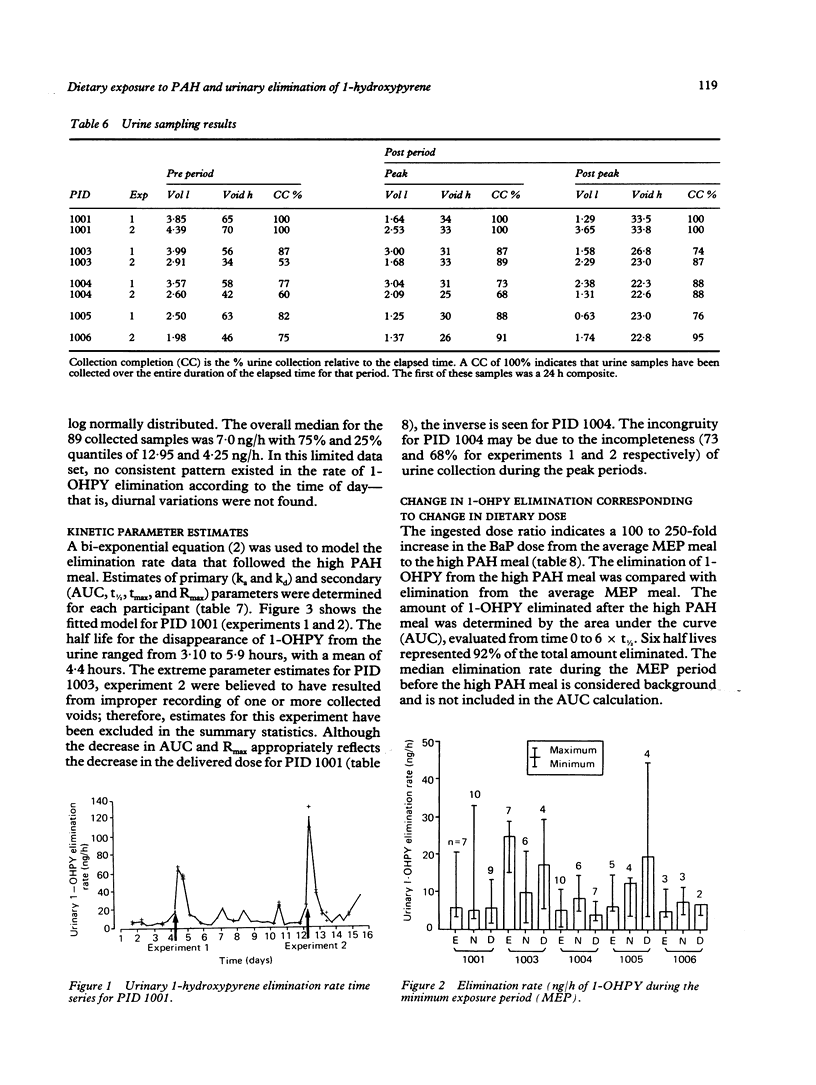Abstract
The significance of diet as an exposure route for polycyclic aromatic hydrocarbons (PAHs) and the associated kinetics of urinary 1-hydroxypyrene (1-OHPY) elimination were examined through a controlled human exposure study. Results showed that a 100 to 250-fold increase in a dietary benzo(a)pyrene (BaP) dose paralleled a four to 12-fold increase in urinary 1-OHPy elimination. Mean elimination rates during minimal exposure periods ranged from 6 to 17 ng/h whereas peak elimination rates of 60 to 189 ng/h were seen after a meal high in PAHs. A biexponential model fitted to a limited number of urinary 1-OHPY elimination points gave mean kinetic parameter estimates for t1/2 of 4.4 hours and tmax of 6.3 hours. It is concluded that dietary exposure to PAHs is potentially as substantial as some occupational exposures and therefore requires consideration in studies of exposure to PAHs. The dietary control strategies and the kinetic parameters defined in this investigation provide data for the control of this exposure route when examining other sources of exposure.
Full text
PDF











Selected References
These references are in PubMed. This may not be the complete list of references from this article.
- Becher G., Bjørseth A. Determination of exposure to polycyclic aromatic hydrocarbons by analysis of human urine. Cancer Lett. 1983 Jan;17(3):301–311. doi: 10.1016/0304-3835(83)90168-4. [DOI] [PubMed] [Google Scholar]
- Becher G., Haugen A., Bjørseth A. Multimethod determination of occupational exposure to polycyclic aromatic hydrocarbons in an aluminum plant. Carcinogenesis. 1984 May;5(5):647–651. doi: 10.1093/carcin/5.5.647. [DOI] [PubMed] [Google Scholar]
- Chipman J. K., Bhave N. A., Hirom P. C., Millburn P. Metabolism and excretion of benzo[a]pyrene in the rabbit. Xenobiotica. 1982 Jun;12(6):397–404. doi: 10.3109/00498258209052481. [DOI] [PubMed] [Google Scholar]
- Dennis M. J., Massey R. C., McWeeny D. J., Knowles M. E., Watson D. Analysis of polycyclic aromatic hydrocarbons in UK total diets. Food Chem Toxicol. 1983 Oct;21(5):569–574. doi: 10.1016/0278-6915(83)90142-4. [DOI] [PubMed] [Google Scholar]
- Foth H., Kahl R., Kahl G. F. Pharmacokinetics of low doses of benzo[a]pyrene in the rat. Food Chem Toxicol. 1988 Jan;26(1):45–51. doi: 10.1016/0278-6915(88)90040-3. [DOI] [PubMed] [Google Scholar]
- Haugen A., Becher G., Benestad C., Vahakangas K., Trivers G. E., Newman M. J., Harris C. C. Determination of polycyclic aromatic hydrocarbons in the urine, benzo(a)pyrene diol epoxide-DNA adducts in lymphocyte DNA, and antibodies to the adducts in sera from coke oven workers exposed to measured amounts of polycyclic aromatic hydrocarbons in the work atmosphere. Cancer Res. 1986 Aug;46(8):4178–4183. [PubMed] [Google Scholar]
- Howard J. W., Fazio T. Analytical methodology and reported findings of polycyclic aromatic hydrocarbons in foods. J Assoc Off Anal Chem. 1980 Sep;63(5):1077–1104. [PubMed] [Google Scholar]
- Jacob J., Brune H., Gettbarn G., Grimmer D., Heinrich U., Mohtashamipur E., Norpoth K., Pott F., Wenzel-Hartung R. Urinary and faecal excretion of pyrene and hydroxypyrene by rats after oral, intraperitoneal, intratracheal or intrapulmonary application. Cancer Lett. 1989 Jul 1;46(1):15–20. doi: 10.1016/0304-3835(89)90209-7. [DOI] [PubMed] [Google Scholar]
- Jacob J., Grimmer G., Raab G., Schmoldt A. The metabolism of pyrene by rat liver microsomes and the influence of various mono-oxygenase inducers. Xenobiotica. 1982 Jan;12(1):45–53. doi: 10.3109/00498258209052453. [DOI] [PubMed] [Google Scholar]
- Jongeneelen F. J., Anzion R. B., Henderson P. T. Determination of hydroxylated metabolites of polycyclic aromatic hydrocarbons in urine. J Chromatogr. 1987 Jan 23;413:227–232. doi: 10.1016/0378-4347(87)80230-x. [DOI] [PubMed] [Google Scholar]
- Jongeneelen F. J., Anzion R. B., Leijdekkers C. M., Bos R. P., Henderson P. T. 1-hydroxypyrene in human urine after exposure to coal tar and a coal tar derived product. Int Arch Occup Environ Health. 1985;57(1):47–55. doi: 10.1007/BF00383545. [DOI] [PubMed] [Google Scholar]
- Jongeneelen F. J., Anzion R. B., Scheepers P. T., Bos R. P., Henderson P. T., Nijenhuis E. H., Veenstra S. J., Brouns R. M., Winkes A. 1-Hydroxypyrene in urine as a biological indicator of exposure to polycyclic aromatic hydrocarbons in several work environments. Ann Occup Hyg. 1988;32(1):35–43. doi: 10.1093/annhyg/32.1.35. [DOI] [PubMed] [Google Scholar]
- Jongeneelen F. J., Scheepers P. T., Groenendijk A., Van Aerts L. A., Anzion R. B., Bos R. P., Veenstra S. J. Airborne concentrations, skin contamination, and urinary metabolite excretion of polycyclic aromatic hydrocarbons among paving workers exposed to coal tar derived road tars. Am Ind Hyg Assoc J. 1988 Dec;49(12):600–607. doi: 10.1080/15298668891380312. [DOI] [PubMed] [Google Scholar]
- Jongeneelen F. J., van Leeuwen F. E., Oosterink S., Anzion R. B., van der Loop F., Bos R. P., van Veen H. G. Ambient and biological monitoring of cokeoven workers: determinants of the internal dose of polycyclic aromatic hydrocarbons. Br J Ind Med. 1990 Jul;47(7):454–461. doi: 10.1136/oem.47.7.454. [DOI] [PMC free article] [PubMed] [Google Scholar]
- Keimig S. D., Kirby K. W., Morgan D. P., Keiser J. E., Hubert T. D. Identification of 1-hydroxypyrene as a major metabolite of pyrene in pig urine. Xenobiotica. 1983 Jul;13(7):415–420. doi: 10.3109/00498258309052279. [DOI] [PubMed] [Google Scholar]
- LIJINSKY W., SHUBIK P. BENZO(A)PYRENE AND OTHER POLYNUCLEAR HYDROCARBONS IN CHARCOAL-BROILED MEAT. Science. 1964 Jul 3;145(3627):53–55. doi: 10.1126/science.145.3627.53. [DOI] [PubMed] [Google Scholar]
- Larsson B. K., Sahlberg G. P., Eriksson A. T., Busk L. A. Polycyclic aromatic hydrocarbons in grilled food. J Agric Food Chem. 1983 Jul-Aug;31(4):867–873. doi: 10.1021/jf00118a049. [DOI] [PubMed] [Google Scholar]
- Lintas C., De Matthaeis M. C., Merli F. Determination of benzo[a]pyrene in smoked, cooked and toasted food products. Food Cosmet Toxicol. 1979 Aug;17(4):325–328. doi: 10.1016/0015-6264(79)90323-7. [DOI] [PubMed] [Google Scholar]
- Lioy P. L., Waldman J. M., Greenberg A., Harkov R., Pietarinen C. The Total Human Environmental Exposure Study (THEES) to benzo(a)pyrene: comparison of the inhalation and food pathways. Arch Environ Health. 1988 Jul-Aug;43(4):304–312. doi: 10.1080/00039896.1988.10545954. [DOI] [PubMed] [Google Scholar]
- Masuda Y., Kuratsune M. Polycyclic aromatic hydrocarbons in smoked fish, "katsuobushi". Gan. 1971 Feb;62(1):27–30. [PubMed] [Google Scholar]
- Obana H., Hori S., Kashimoto T., Kunita N. Polycyclic aromatic hydrocarbons in human fat and liver. Bull Environ Contam Toxicol. 1981 Jul;27(1):23–27. doi: 10.1007/BF01610981. [DOI] [PubMed] [Google Scholar]
- Reddy M. V., Gupta R. C., Randerath E., Randerath K. 32P-postlabeling test for covalent DNA binding of chemicals in vivo: application to a variety of aromatic carcinogens and methylating agents. Carcinogenesis. 1984 Feb;5(2):231–243. doi: 10.1093/carcin/5.2.231. [DOI] [PubMed] [Google Scholar]
- Santodonato J., Howard P., Basu D. Health and ecological assessment of polynuclear aromatic hydrocarbons. J Environ Pathol Toxicol. 1981 Sep;5(1):1–364. [PubMed] [Google Scholar]
- Venier P., Clonfero E., Cottica D., Gava C., Zordan M., Pozzoli L., Levis A. G. Mutagenic activity and polycyclic aromatic hydrocarbon levels in urine of workers exposed to coal tar pitch volatiles in an anode plant. Carcinogenesis. 1985 May;6(5):749–752. doi: 10.1093/carcin/6.5.749. [DOI] [PubMed] [Google Scholar]
- Yamasaki E., Ames B. N. Concentration of mutagens from urine by absorption with the nonpolar resin XAD-2: cigarette smokers have mutagenic urine. Proc Natl Acad Sci U S A. 1977 Aug;74(8):3555–3559. doi: 10.1073/pnas.74.8.3555. [DOI] [PMC free article] [PubMed] [Google Scholar]


